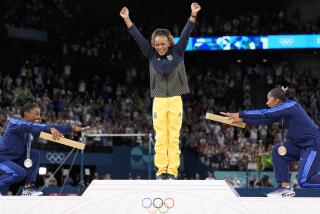Five Linked to New Steroid
- Share via
The scope of an international doping probe expanded Wednesday with revelations that five athletes -- four unnamed Americans and British sprinter Dwain Chambers -- tested positive this summer for a new designer steroid that was previously undetected.
The scandal that erupted six days ago has cast a shadow on track and field, especially in the United States. Its effects are quickly being felt in other sports.
Even as U.S. officials announced the test results of the four Americans on Wednesday, it was disclosed that federal investigators asked boxer Shane Mosley to provide urine samples that were taken after his recent fight with Oscar De La Hoya. Pro leagues such as the NFL said they were considering retesting samples from their athletes.
At the center of the controversy is a small Burlingame, Calif., company called Bay Area Laboratory Co-Operative (BALCO) that markets nutritional supplements.
Dozens of the company’s regular clients -- including San Francisco Giant slugger Barry Bonds -- have been subpoenaed to appear before a federal grand jury in San Francisco. It was previously reported that authorities were scrutinizing BALCO on suspicion of violating tax and money-laundering laws.
However, the request for Mosley’s urine sample suggests a broader investigation into banned drugs. Mosley also has been subpoenaed to appear before the grand jury, his attorney confirmed.
The U.S. Anti-Doping Agency has accused BALCO of designing and distributing the new steroid -- called tetrahydrogestrinone, or THG -- that turned up in the retesting of 550 samples taken from athletes at various times in the summer.
BALCO’s owner, Victor Conte, has denied any wrongdoing in e-mails to The Times and other news outlets.
With the anti-doping agency calling this case perhaps the most significant steroid bust in Olympic and U.S. sports history, some have pointed to a silver lining: Officials identified a previously unknown substance, then went back to test samples taken at a time when cheating athletes had no reason to suspect they might be caught.
U.S. distance running champion Deena Drossin hoped this development might “scare people in the future from using performance enhancing drugs.”
On Wednesday, officials from USA Track & Field (USATF) went a step further by proposing tougher drug rules that could include fines of up to $100,000 or lifetime bans for first-time steroid offenders. A positive steroid test currently results in a two-year suspension in most cases.
Much of the sporting world, however, remained skeptical.
“This whole notion -- ‘Oh, now we’re going to get tough on you’ -- they’ve got to say this,” said Charles Yesalis, a Penn State professor who has studied drugs in sports. “They’ve been embarrassed all over the world the last few days.”
USATF officials, however, said it is a start.
“I think it has to be twinned with an admission on our part that we have not done everything we could have done on this issue in the past,” USATF Chief Executive Craig Masback said in a conference call with reporters.
“I think we have to begin with admitting we haven’t been as aggressive as we could have been, and admitting there is a problem in our sport, as I say, even if a single athlete is cheating.”
Mosley’s attorney, Judd Burstein, said Wednesday that his client, who uses BALCO products, passed all drug tests after the Sept. 13 fight against De La Hoya in Las Vegas. Burstein said that urine sample has been discarded.
But track and field officials said they have saved samples from their athletes.
USADA said it discovered the existence of THG after receiving a tip from an anonymous, self-described “high-profile” coach in June. The tipster provided an example, which was forwarded to a testing lab at UCLA.
Once the lab identified and developed a test for the substance, officials began their re-examination.
Samples are normally divided into two parts, A and B. Chambers, for instance, underwent an out-of-competition test in Germany in August and was notified that his A sample was positive for THG, according to a statement issued by Graham Shear, Chambers’ attorney.
To confirm a steroid positive, the B sample must also turn up the presence of THG. The B samples will be tested this week or next, a source said Wednesday, speaking on condition of anonymity.
Chambers had emerged as one of Britain’s best hopes at the 2004 Games. He trained in the U.S. with Remi Korchemny, a coach well-known in track and field circles; Korchemny “instructed” him to use Conte as his nutritionist, according to the statement issued Wednesday.
Chambers, the statement said, “will not tolerate nor accept any accusations or implications that this was a willful or calculated attempt on his behalf to deceive the authorities.”
Although track athletes have been the ones making most of the headlines, athletes from seven other U.S. sports federations have been sanctioned for doping violations in 2003, including seven swimmers and four cyclists.
Of the four U.S. track athletes who tested positive this summer, three competed in the World Championships in Paris. None earned a medal, officials said.
Masback said, “If I were to be critical of USATF -- and, frankly, of myself -- over the last few years, we have perhaps been too aggressive in taking the defense or the right of a single athlete and placing those ahead of the needs of an entire sport or the reputations of the larger group of athletes.”
*
Times staff writers Helene Elliott and Steve Springer contributed to this report.
More to Read
Go beyond the scoreboard
Get the latest on L.A.'s teams in the daily Sports Report newsletter.
You may occasionally receive promotional content from the Los Angeles Times.











